
Greutăți și măsuri
| Lungime | de la 14 la 19,5 cm |
|---|
Descrierea animalului
The Dunnock, scientifically named Prunella modularis, is a small passerine, or perching bird, that belongs to the accentor family. This bird is primarily found across Europe and into Asia, inhabiting a wide range of environments from dense forests to open gardens. Despite its widespread presence, the Dunnock often goes unnoticed due to its unobtrusive behavior and the subtlety of its appearance.Physically, the Dunnock presents a rather modest appearance, characterized by its streaked brown and grey plumage which serves as excellent camouflage against the forest floor and undergrowth where it prefers to forage. This bird measures about 14 cm in length, with a wingspan of around 19 to 21 cm, making it similar in size to a common sparrow. However, unlike sparrows, Dunnocks have a more slender build and a fine, pointed beak which is well-adapted for their insectivorous diet, although they do supplement their meals with seeds, especially during the winter months.
One of the most distinctive features of the Dunnock's behavior is its complex social and breeding systems. They can form polygynous, polyandrous, or monogamous pairings, depending on environmental conditions and the density of the population. This flexibility in mating systems is quite unusual among European songbirds and has been a subject of interest among ornithologists. The Dunnock's song, a fast, twittering melody, is often heard in the early spring as males stake out their territories and seek to attract mates.
The nest of a Dunnock is a neat, cup-shaped structure, often concealed in dense shrubbery or hedges close to the ground. The female is primarily responsible for the construction of the nest, which she lines with moss, hair, and feathers to create a soft bed for her eggs. The clutch size varies from three to five eggs, which are incubated for about two weeks before hatching. The chicks are altricial, meaning they are born blind and featherless, utterly dependent on their parents for food and warmth. Both parents, and sometimes additional adults in polyandrous or polygynous groupings, share in the feeding and care of the young until they are ready to fledge.
Despite its common status and adaptability to human-altered landscapes, the Dunnock's populations are monitored for potential declines due to habitat loss and changes in agricultural practices that may affect their food supply. Conservation efforts focus on preserving natural habitats and promoting gardening practices that support a diversity of insect life for these and other insectivorous birds.
In conclusion, the Dunnock, Prunella modularis, is a fascinating bird that embodies the complexity and beauty of avian life. Its unassuming appearance belies a rich behavioral repertoire and an ability to thrive in a variety of environments, making it a cherished presence in its native habitats across Europe and Asia.
Animale similare
Fotografii noi cu animale
Top 10 animale
- Dolphin gull (Leucophaeus scoresbii)
- Diana monkey (Cercopithecus diana)
- Moustached guenon (Cercopithecus cephus)
- Galápagos tortoise (Geochelone nigra complex)
- Stone loach (Barbatula barbatula)
- Japanese macaque (Macaca fuscata)
- Greek tortoise (Testudo graeca)
- Russian tortoise (Testudo horsfieldii)
- Common flying dragon (Draco volans)
- Galápagos penguin (Spheniscus mendiculus)
